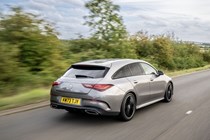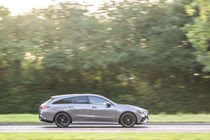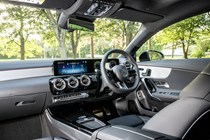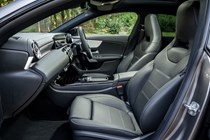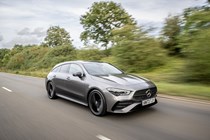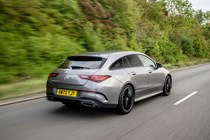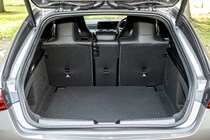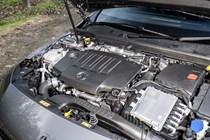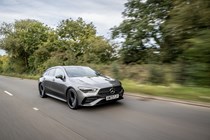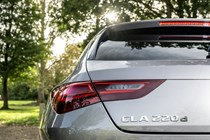
Mercedes-Benz CLA Shooting Brake long-term test
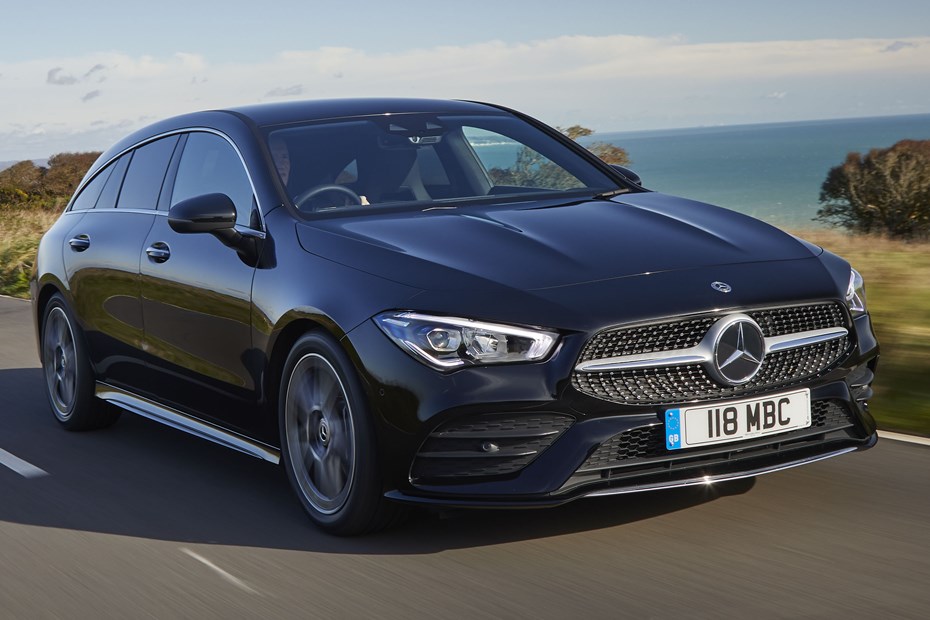
We’re living with a Mercedes-Benz CLA Shooting Brake for six months
Now that the A-Class is a whole family of cars it represents ‘your entry level to Mercedes’ on several fronts (assuming you’re not looking at super-competitive finance deals, which can make a C-Class better value, or a B-Class really tempting). The CLA Shooting Brake is the ‘small estate’ – but all is not as it seems…
Representing the most aspirational values of the group, the CLA Shooting Brake sits above the the A-Class hatchback (which is now technically as big as, and almost identically engineered to a Golf or Focus) and Saloon, offers a lower profile than the GLA SUV, and is a sister model to the CLA four-door coupe (or ‘slightly slippier-looking saloon’) .
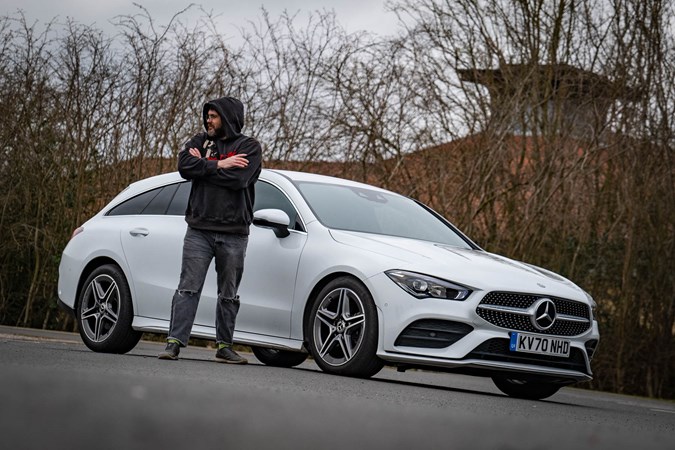
We’re just missing a roadster or convertible.
The SLC was discontinued in 2021, Will there be a Mercedes SLA in the future?
There was a time when a Mercedes ‘class’ was simply a car. It might have variations such as an estate or convertible but they all looked basically the same, and an A-Class was the smallest Mercedes, a single car with just a choice of engines.
Not only that, the A-Class was a car that stood out from the pack – when Mercedes wanted to make its first mass-produced front-wheel drive car it didn’t follow the herd, it innovated.
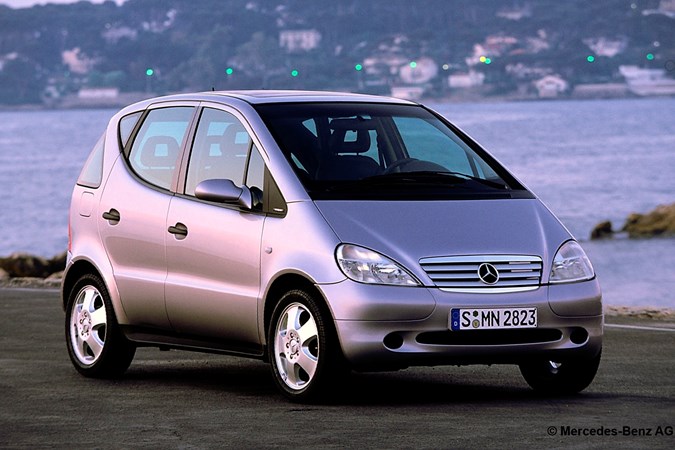
This, to me, is what an A-Class is – the 1990s ‘cramming family-hatchback space into the footprint of a city car’ original.
But now we have classes that could be a whole marque in their own right, crossing boundaries of size, performance and cost, and the CLA Shooting Brake exists at the point at which four aspirations meet; style and luxury, family practicality, sporty performance, and ease of parking or fitting into the urban landscape.
It’s a car that’s torn in several directions, yet in some ways, it’s a great solution for all of these needs.
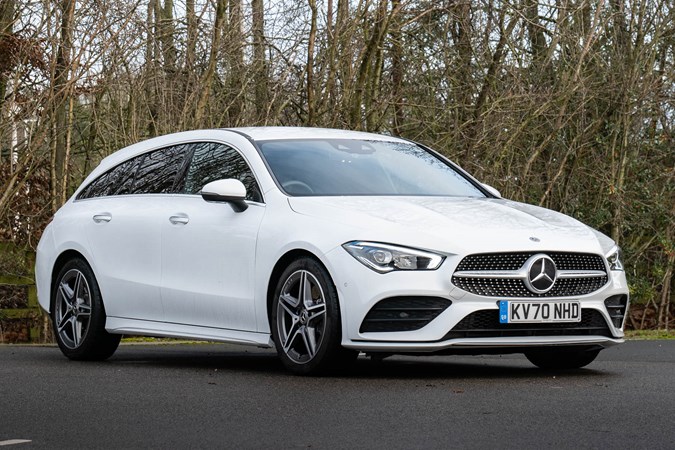
Learn more about our CLA Shooting Brake, and what it’s like living with the small upmarket ‘coupe-estate’ via the links below.
Update 1: What is it?
Update 2: James Dennison borrows the CLA
Update 3: What’s it for?
Update 4: Keith WR Jones enjoys the CLA… at night
Update 5: What do you get with it?
Update 6: Rivals – Golf Style Estate and GLA 250 e
Update 7: Verdict
Update 1: Our CLA Shooting Brake – CLA 220 d AMG-Line Premium
From a rational point of view, this is the nicest A-Class for drivers who don’t want a big, bulky SUV.
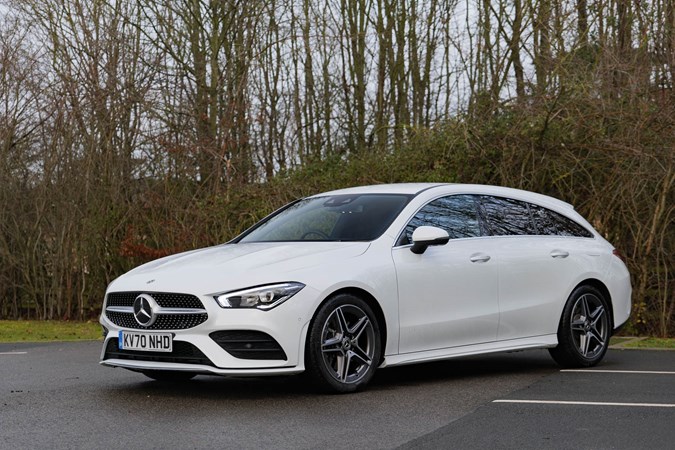
Not only is it an appealing shape, inheriting the classy style of the CLS Shooting Brake without the size and cost, it’s also remarkably practical. To understand what it’s like living with the CLA Shooting Brake we got a very typical, popular lease configuration.
It’s an AMG-Line Premium with big wheels and some nice kit, and it’s in white with a black Artico leather interior, with no sunroof, and no major options; if you’re buying one you’ll have much more flexibility around packs and trim, and these could transform the character of the car and really leverage that upmarket, CLS-inspired style.
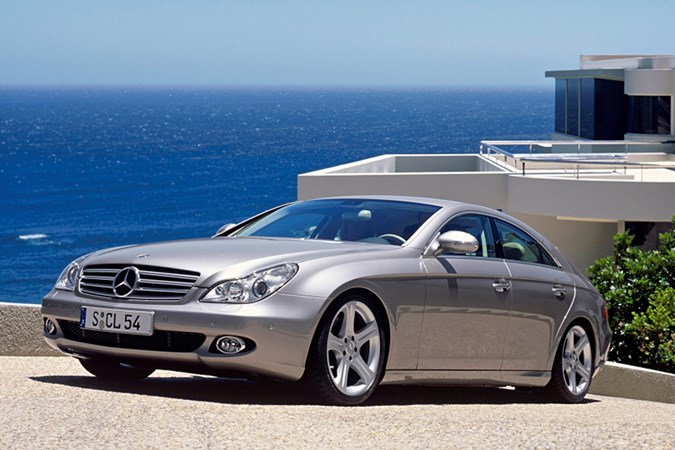
Mercedes would suggest that the CL part of CLA implies a decadent, style-first choice of car – though with only a handful of paint colours to choose from the bespoke feel is somewhat lost.
You can have white, metallic white, silver, grey, black or red, unless you go for an AMG version.
Interior-wise you can select black, or one of three two-tone combinations at no extra cost – brown, titanium grey, or striking red over black. It seems dark metallic blue and cream leather is out for 2020/21, which is a shame as it’s a scheme that really suits Mercedes’ subtle curves.
Specification as tested:
- £38,390 AMG-Line Premium CLA 220 d
- 54.4mpg and 135g/km CO2
- 0-62mph 7.2 seconds, and up to 147mph
- 4,695mm long, 1,433mm high, 1,999mm (1,830mm*) wide
- Wheelbase 2,729mm
Compared to the equivalent A-Class
- £35,895 AMG-Line Premium A 220 d
- 55.4mpg and 133g/km CO2
- 0-62mph 7.0 seconds, up to 146mph
- 4,419mm long, 1440mm high, 1,992mm (1,796mm*) wide
- Wheelbase 2,729mm
*excluding mirrors
Crucially the front track – the width between the centre of the wheels – is 34mm wider on the Shooting Brake (reflected in the width at the wheels, too), which generally contributes to a more stable, sporty feel.
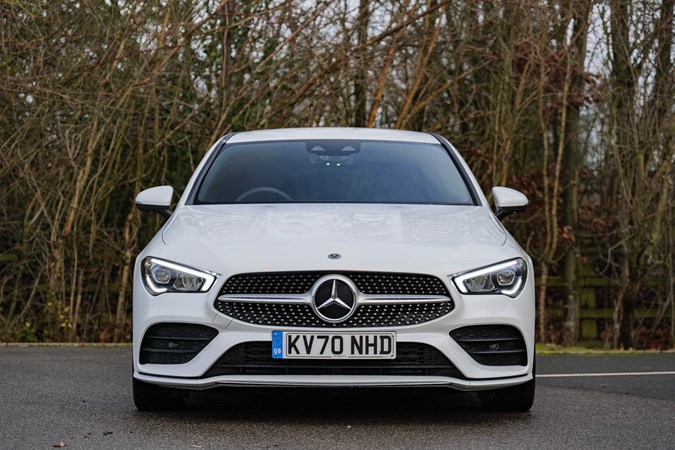
This detail could merely be the difference between the standard wheels on an A-Class and the higher, sportier spec of the CLA Shooting Brake, but just look at it. It’s low, wide and purposeful with a subtle flare to the arches at the front.
How does the CLA Shooting Brake drive?
Good news! There are sufficient subtle changes to the CLA to make it feel like a much sportier car than the A-Class, not least of which is the standard fitment of the more sophisticated independent rear suspension usually reserved for the most powerful models.The seating position is lower, too, and the wide, squat stance helps it feel really enthusiastic, responsive and secure in corners.
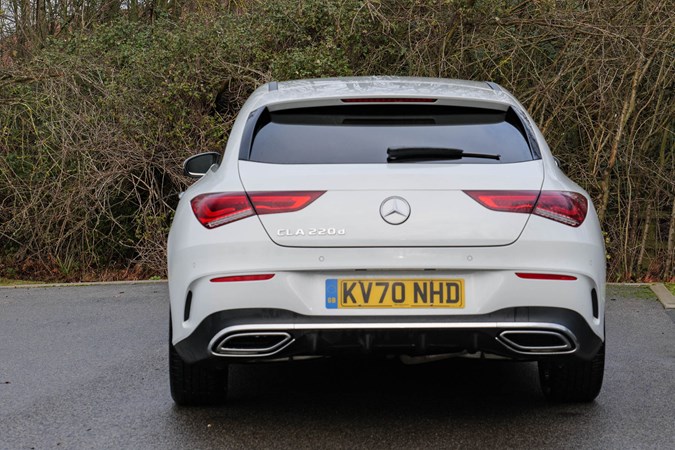
With the 2.0-litre diesel of the 220 d there’s plenty of power to get away from the lights, and it’ll cruise on motorways for hours with low noise and fuel consumption. One thing Mercedes consistently gets right is the automatic gearbox, which does its thing unobtrusively – there are paddles for quick manual shifts, and a column stalk to select forward or reverse.
The low suspension isn’t very well suited to rutted fenland roads, but it does a good job of isolating smaller imperfections. Ride comfort doesn’t suffer particularly, either, though it does mean that harsher ruts or speed bumps can occasionally skim the front bumper even when being approached with care and low speeds; given that this is hardly a track-focused Mercedes-AMG specification it’s an unexpected quirk to have to drive around.
Does the CLA Shooting Brake feel special?
From the outside, it’s a very good-looking car. The curve of the rear arches and tailgate evokes the AMG GT and more upmarket Mercedes coupes, and there’s a very Porsche 911-esque curve to the rear three-quarter view, emphasising how tapered the load area really is.
The profile really works best from a low angle; stand up, and the bulk of the rear pillar over the tapering arch of the glass looks a bit heavy in a flat white shade. You’re glad it doesn’t follow the shape of the windows when you’re in the car, though, as the headroom and space for passengers is better than in an A-Class hatchback.
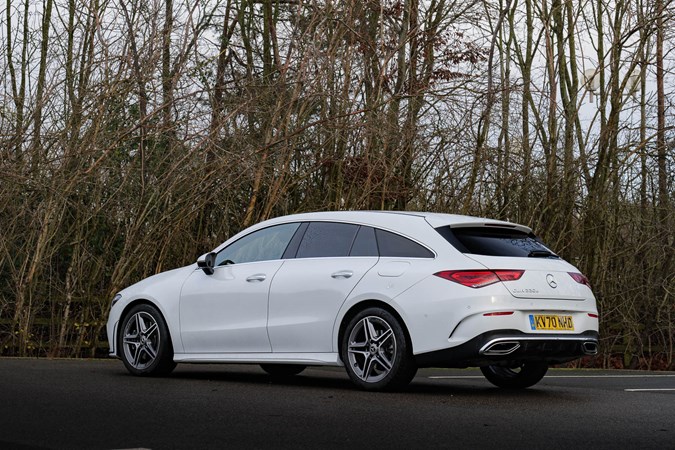
Speaking of the hatchback, though, aside from the frameless doors the interior is the same as any AMG-Line A-Class. That’s not a bad thing by any means, it’s one of the classiest interiors you’ll find in a front-wheel drive, premium hatchback, with a great blend of tech and traditional hardware controls.
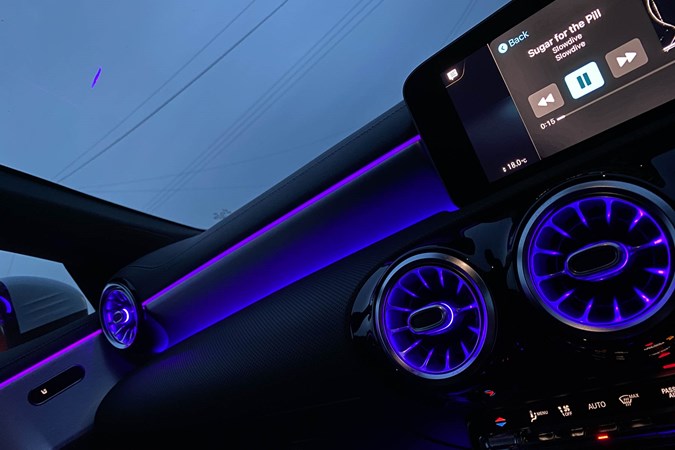
The Premium pack introduces animated ambient lighting which is really impressive, though you’ll find yourself appreciating the ability to say ‘Hey Mercedes – ambient light off’ when reversing or driving in town, as it reflects off the interior side windows like nothing else.
As always, there are reminders that you could have a higher-spec car… the silver plates at the top of the doors where you would find electric seat adjustment or extra speakers feel very spartan. But shiny.
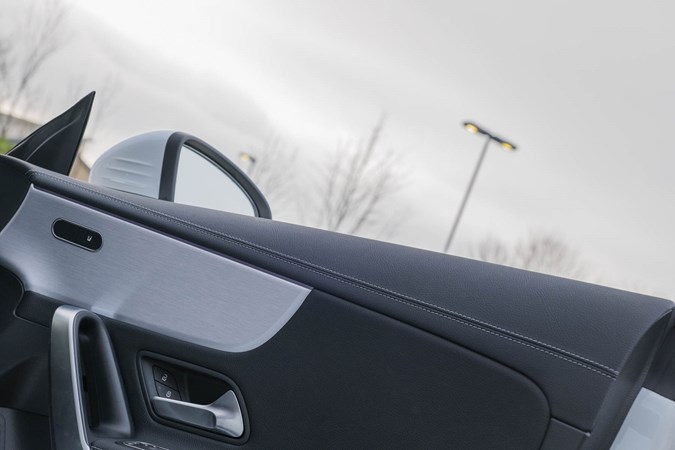
Even with manually-adjusted seats and mid-range audio it’s a nice place to sit, just… not near-£40,000 nice when you consider what you could get elsewhere.
What’s annoying in the CLA Shooting Brake?
First impressions count, and the CLA’s initial impact is hampered by a couple of niggles. Or rather, rattles; in A 220 d form when the weather’s cold, the interior shakes and buzzes like an old bus. Some of this turns out to be the plastic tray for the handbook, which lives in the glovebox but tucked out of sight.
That one settles down when the car’s warmed up a bit. However, there’s a persistent buzz from the B-pillar or door trim, a whistle at 60mph near the top of the windscreen, and a few other squeaks and chittering noises that anyone who has owned a lot of Mercedes cars will be used to in winter.
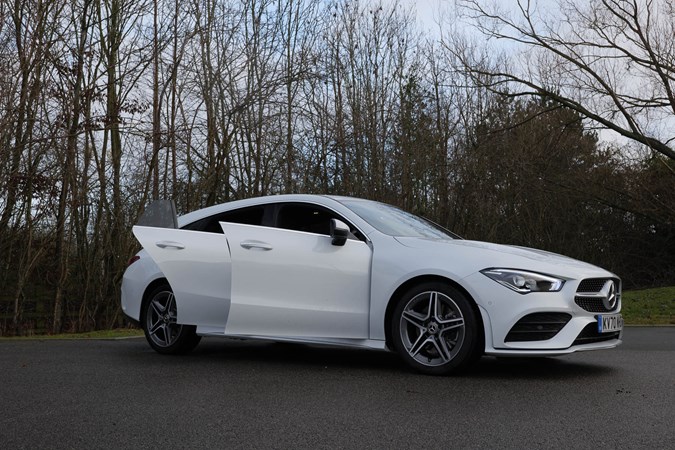
Refinement overall is acceptable – it’s just from a cold start the 2.0-diesel’s vibrations are really not well isolated. Perhaps it’s a way of ultrasonic-shedding the snow and ice from the car.
Like other Mercedes cars I’ve driven with LED, non-adaptive headlights, the beam pattern is very bright, but cuts off abruptly and seemingly, very close to the front of the car compared to other vehicles. This feeling of driving into darkness is naturally exacerbated by the interior lighting and massive screens before you’ve adjusted everything to your taste.
And the final irritating niggle? The wireless charging pad lives under a little roller-style cover that looks impressive when closed. It’s behind the cupholders and the USB-C connection for Apple CarPlay or Android Auto is there too, despite the presence of USB ports in the large centre storage box. The tray is so narrow you can’t fit a cable to your phone and drop it in the tray properly, there’s no wireless Apple CarPlay support, and you can’t just put the phone in the tray and close it.
This is something that should be easy to fix – until wireless CarPlay is introduced, just make the centre storage USB ports the ones for smartphone integration. It’s also a smaller niggle than the size of the paragraph above implies, because the infotainment is very, very good – more on that later.
Having just taken delivery of the CLA Shooting Brake, though – and managed one drive in it, to make a video about a Vauxhall Mokka – ‘my’ Mercedes is needed elsewhere…
Update 2: JD borrows the Mercedes-Benz CLA Shooting Brake
Just as the UK lockdown 2.0 occurred in early November, I found myself between long-termers. My BMW 420i was arriving in a few weeks (read about it here), but in the meantime I needed something to plug the gap for essential journeys and, happily, Richard kindly offered his CLA Shooting Brake.
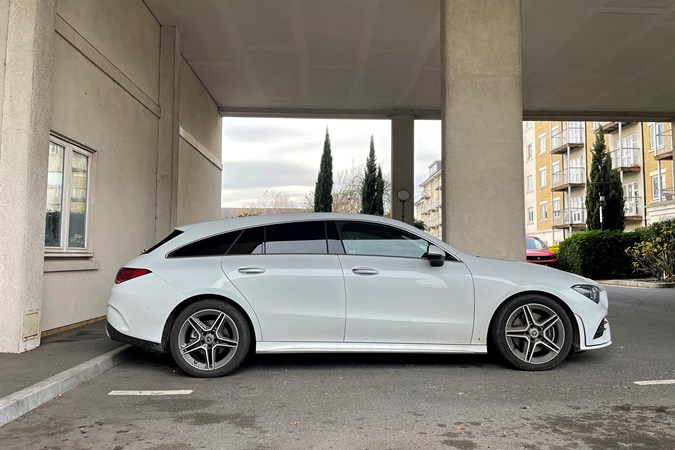
I’ve always liked how these things have looked, yet never really seen the appeal of them as a buying proposition. Slightly bigger than an A-Class hatch but nowhere near as roomy as a lightly used C-Class wagon, it seems to sit in a middle ground of curious compromise.

Here, however, was as good an example of the breed as many buyers would realistically be looking at – an AMG Line Premium 220 d. So, if it was going to change my mind, then surely this would be its best shot.
2.0-litre diesel reminds us what we’ll be missing
I’m not anti the electric car revolution, yet I think it’s a crying shame we’re going to have to say goodbye to engines as fit for purpose as the one in this CLA. A 190hp 2.0-litre, it’s the only diesel in the range and if you do big miles, it’s worth serious consideration. Not least because when I picked the car up on three-quarters of a tank, it still wasn’t quite empty when I returned it three weeks and several hundred miles later. A theoretical range of near 700 miles (and maybe more given I was getting upwards of 55mpg) is, put simply, an incredibly useful thing to have.
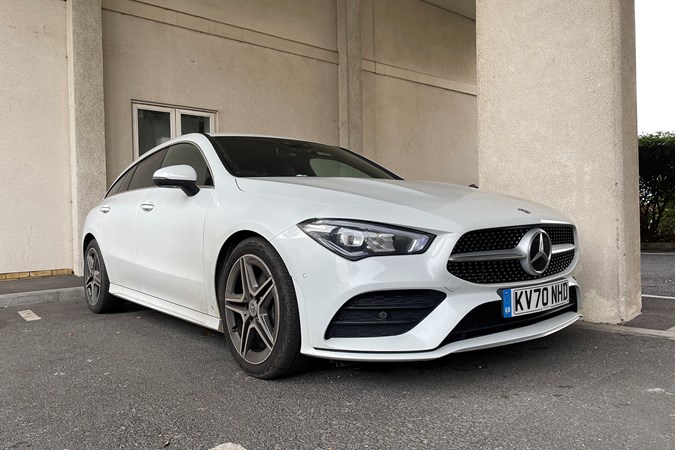
A note too, on performance and refinement. Like most Mercedes diesels I’ve driven, this pulls harder than you’d reasonably expect and it’s 7.2-second 0-62mph time feels conservative. More importantly, there’s ample in-gear torque (400Nm from 1,600rpm) that works nicely with the eight-speed automatic gearbox. And while refinement isn’t quite up there with petrol equivalents, noise levels are perfectly reasonable at a cruise.
Start-up procedure
I found myself going through a set start-up sequence in the CLA. Hop in, do the usual, hit the engine start button then go immediately to the car settings shortcut and turn the uber-sensitive Active Lane Keeping Assist function off. I should point out that this is the first car I’ve ever felt compelled to do this in – I’ve never had any trouble with lane keeping aids, or any other driving assistance tech before.

Yet for some reason, the CLA’s only needed the slightest provocation to strongly apply the brakes on one side of the car. And then, on another occasion, it hit the brakes sharply without another car or lane marking anywhere near. Hmmmm.
Final thoughts
In isolation, the CLA Shooting Brake is a good car. A 7/10 in this spec, in fact. And I can appreciate the appeal of an A-Class with a larger boot and sleeker styling. Yet given the average CLA is a few thousand dearer (admittedly with more kit and a more powerful engine) than the average A-Class, it’s certainly worth considering how much you really want the extra benefits.
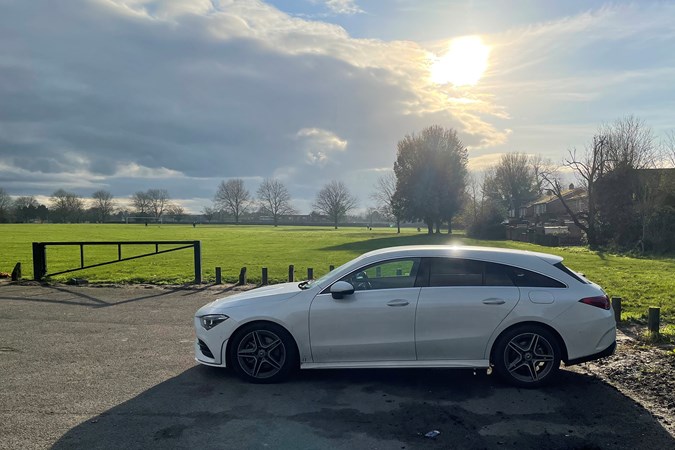
Rest assured that if you do decide you want one, however, there’s a solid car underneath. Minus the Active Lane Keeping.
Update 3: What is the CLA Shooting Brake for, exactly?
Maybe it’s because it’s white and quite unassuming. Maybe it’s because it’s one of the few cars I’ve seen in that shade that doesn’t have the panoramic sunroof – or even a two-tone roof – so it looks a bit like an appliance.
Either way, I’ve found it harder than usual to get to know the character or ‘personality’ of the CLA Shooting Brake. Often what I drive will influence how I feel and behave as much as I’ll choose something to suit what I like, but I’m worried that the CLA is just too sophisticated for someone who likes their cars ‘robust’ or very focused on doing one thing well.
In short, I think the CLA Shooting Brake may be out of my league. It’s wine bars, not dive bars, New Look rather than New Rocks.
Not that we’re going to any bars these days…
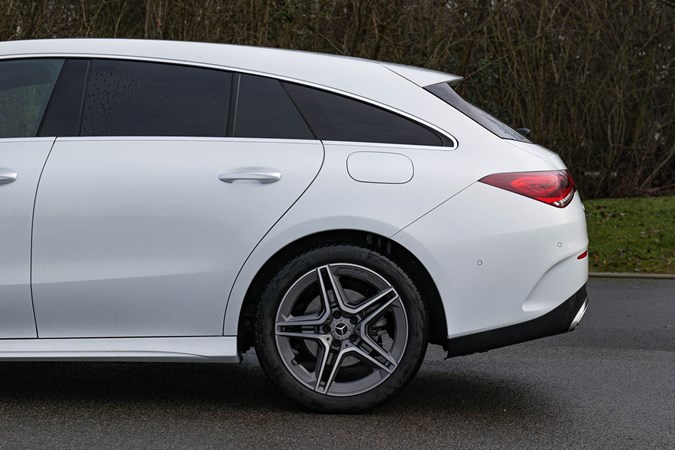
Yet I’m a big fan of the idea the car represents.
Traditionally the ‘shooting brake’ is a class of car that translates well for enthusiasts, and it’s born out of the inevitable clash of desires for a focused, high-performance car (which would have had two doors and a boot for maximum body strength) and something practical, with a bit of load space.
Usually, you start with an overtly sporty two-door car, then add a thoroughly sensible estate-style back to it. There are many examples of the traditional shooting brake; conversions of classic Aston Martins and Jaguars (the XJ-S based Lynx Eventer is one of the most famous) so the low, fast and posh machines could also carry a few guns, picnic hampers and a bit of game.
Not the travel Monopoly kind. The deer and pheasant kind.
When Mercedes introduced the svelte CLS, which brought the four-door coupe to the modern motoring vernacular and was visibly very different to an E-Class or an S-Class – sort of bridging the two in terms of status – it took a while to follow up with a practical family version.
It’s debatable whether a CLA ‘coupe’ was ever needed alongside the saloon and hatchback, given the CLA also has four doors. The CLA Shooting Brake, even if it is on the same wheelbase as the hatch, makes more sense than the ‘slightly lower A-Class Saloon’ of the regular CLA though; this is what we get instead of an A-Class Estate (Mercedes would probably argue that if you want that, get a B-Class despite it being shorter than the CLA).
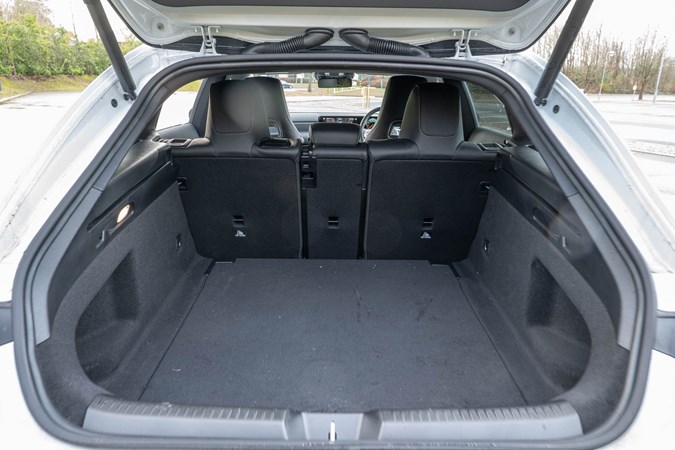
Thanks to that long boot floor, it has proven more practical than an A-Class in most circumstances, and though there’s a drop into the floor over the boot lip, it’s not too high to load things into it and it keeps your shopping in place.
Style with practicality? Or practicality compromised for style?
Lockdown limits the opportunity for adventures, but a quick trip to collect some furniture from a charity demonstrated the ample length – if not width – of the load area with the seats folded down.
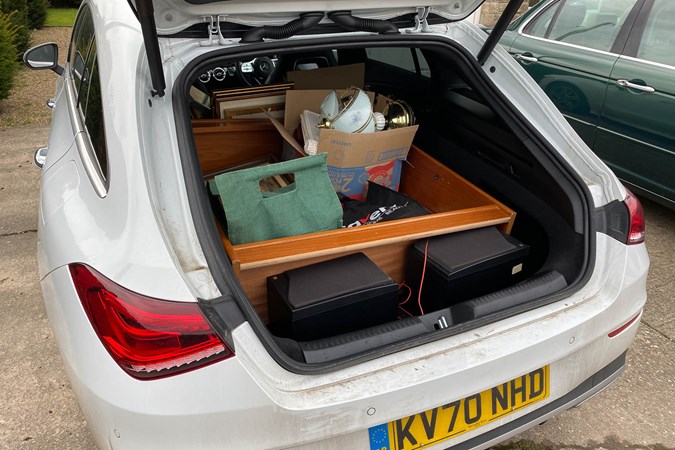
And the seats are very easy to fold.
It’s not all good news though, as though the boot floor is pretty roomy, the boot opening is another matter. Faced with an IKEA desk top, at 120cm wide, there was absolutely no way it was going to go in – the elongated slope of the tailgate looks big, but the best you’ll manage is 110cm diagonally and even then, you’ve got to navigate the trim around the rear windows.
Carrying tables probably isn’t the point. It’s got plenty of room for luggage for four adults, and in Mercedes-AMG form with a refined, potent petrol engine it would be a lovely cross-continent tourer – city-friendly, fun on country roads, spacious and very good looking without being unsubtle.
With those aspirations in mind, the CLA Shooting Brake does become more appealing – just not with the diesel engine, and really, it needs the upgraded interior with two-tone trim and either Patagonia Red or Mountain Grey.
The UK gets a very narrow selection of colours, though – a shame when this distinctive shape would suit Mercedes’ denim blue, or better yet the rich, vibrant Brilliant Blue. White really does leave it looking too much like a rental car from many angles. Thanks to the ‘first impression’ on every winter drive from that diesel, I think I’d almost prefer it even with the basic A 180 petrol; the ideal being the A 250 e hybrid.
The diesel’s powerful and economical, so why recommend petrol?
The diesel’s lack of refinement when cold and in winter weather mars what is otherwise a very appealing engine and performance package; if I hadn’t driven the car in cold weather I don’t think I’d have noticed it as much – and as more time is spent with the car, I’m starting to understand the values behind the design. When it’s being a little agricultural in town or when warming up, it makes me think of a pair of Louboutins, but with those thick rubber soles you can get to stick on to make them practical without spoiling the trademark blood-red lacquer.
Where I’ve been thinking of it as a cut-down four-door GT (and good looking with it), but compromised just the right amount to appeal to a wide enough group of buyers to be worth selling (worth remembering, when it looks like there’s no sign of a replacement for the CLS Shooting Brake), when what it probably is is just a small estate car, but one of the best looking ones you’ll get.
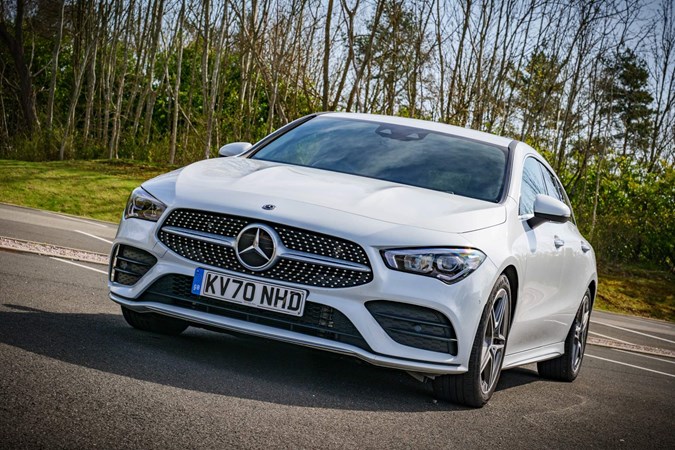
In fact with the roomier rear seats, the undeniably large boot below the window line, and features like an electric tailgate and rear windows that fully wind down and give a better view out than many ‘sensible’ cars, the CLA Shooting Brake is shaping up to be a very capable family car.
So to answer the question ‘What’s the CLA Shooting Brake for?’, it’s proving you can be useful and practical in the real world without giving up good looks and a bit of fun behind the wheel.
It’ll carry two kids and a big buggy easily without forcing you into driving a monster truck or something resembling a small bus. Its personality is beginning to come through… and I’m not afraid to admit that it’s taken a while to click for me, because I’m a middle-aged empty-nester and far from stylish or fashionable.
By Richard Kilpatrick
Update 4: Night rider
As a previous custodian of two of Parkers’ long-term Mercedes in previous years, with both an S-Class and a V-Class, I was keen to sample Richard’s slinky CLA Shooting Brake, so when he asked borrow my long-term Vauxhall Vivaro Life I seized the opportunity to suggest a swap.
While the CLA isn’t the kind of car that normally attracts me, there’s something rather sensuous about the gentle curvature of its bodywork that’s appealing, despite the best efforts of the Hotpoint-alike paint job to dent its lustre.
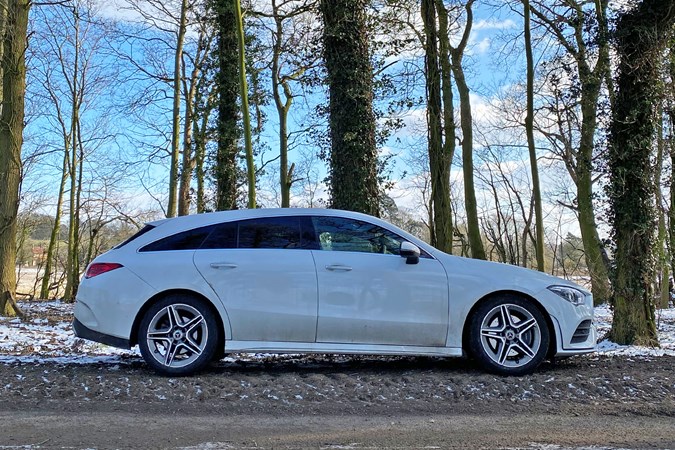
It seems others agreed: after posting a picture of its hind quarters on my Instagram account, I was subjected to a flurry of approving direct messages, and none were from Russian spambots either, which was nice.
Clatterbox
On paper, the CLA 220 d’s diesel engine looks like it could be the sweet spot in the range, yet it conspired against itself in conspicuous fashion.
Starting from cold, this particular Shooting Brake suffers from the most serious vibration of any new car in recent years. It resonates through any and every surface throughout the cabin – I reckon you could rest your head on the steering wheel and give your teeth an ultrasonic clean.
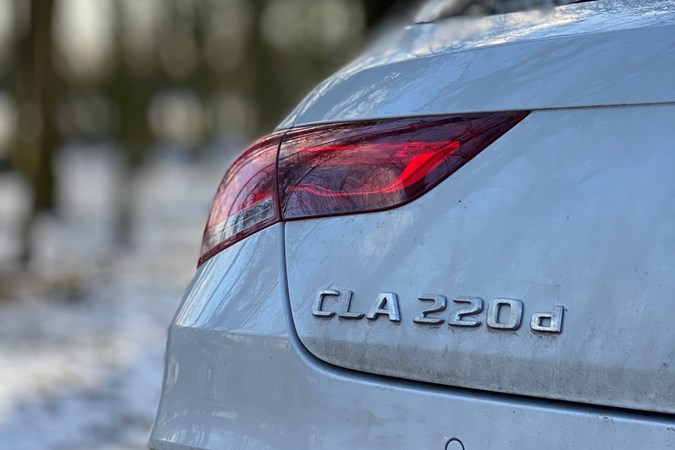
Once on the move that – thankfully! – all stops. Somewhat ironically given the nuisance it makes of itself initially, on the move its pleasingly hushed, but it falls short of how punchy I expected it to feel given the 0-62mph claim of 7.2 seconds.
Nevertheless, it feels assured when completing overtaking manoeuvres and there’s no sniffing at 57mpg while zipping about, either.
Snug as a bug in a rug
From a position of isolation, the CLA’s A-Class-based interior looks slick, with glossy surfaces, a dual screen facia and a general air of sleek minimalism.
As well-assembled as it is, material quality feels below par for a car costing almost £40,000. Plastics can be convincingly made to look and feel like all manner of materials these days, yet the Mercedes’ cabin feels like a celebration of black, well, plastic.
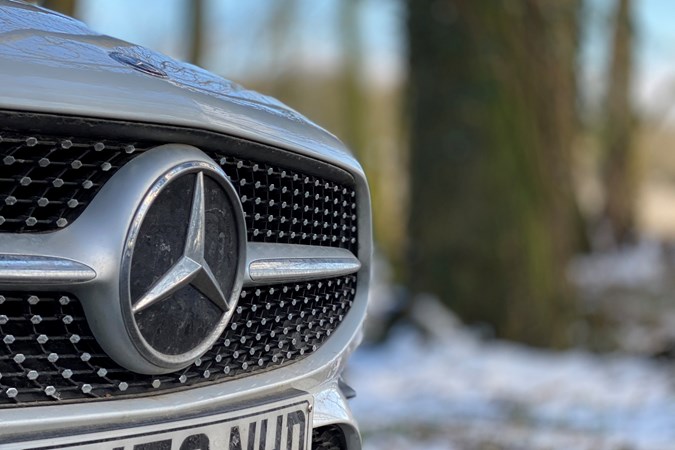
Poaching some interior specialists from Volkswagen Group might be a way forward.
Given the Shooting Brake’s low-slung looks, it’s a pleasant surprise to find I can sit my 6-foot tall frame front or rear in decent comfort, although alighting from the back with any degree of grace was something that past me by. An orangutan could peel off a wetsuit with more dignity intact.
Milk round
After a couple of days brief drives, I wasn’t especially enamoured with the compact Mercedes wagon. Yet, the necessity of a night-time drive for an essential drive to purchase some semi-skimmed shone a different light on things.
You see, one aspect of interior car design that I believe Mercedes really has nailed is the use of ambient light, particularly when in animated, multi-coloured modes.
Clubs and bars may not be open for a few months yet, but we can still enjoy a rave inside our brightly-lit @MercedesBenzUK CLA Shooting Brake long-term tester!
Read our thoughts so far here: https://t.co/ln2cv5C4yl pic.twitter.com/C5oMcYzHlz— Parkers (@ParkersCars) March 1, 2021
Varying levels of intensity create dramatic effects all-round the interior, the varying degrees of surface sheen causing it to be reflected and refracted differently.
It’s gentle, too, meaning those waves of colour shifts don’t distract you from the task in hand – driving in other words – but rather have a calming influence. I genuinely felt chilled and tried it a few more times with other after-dark drives. Each made the CLA feel that bit more special than it did in the daylight.
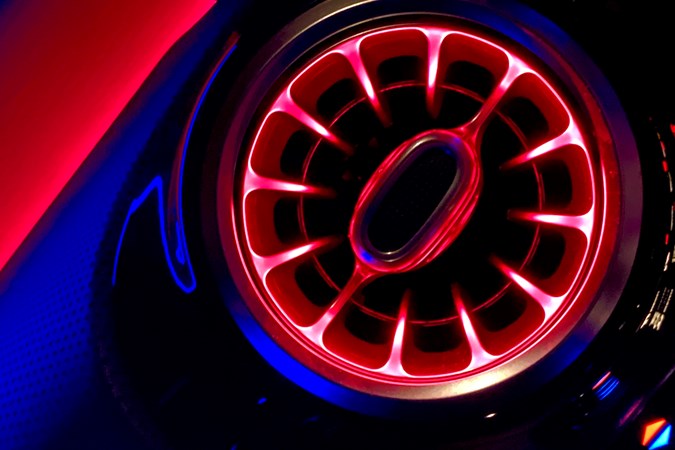
Am I recommending you buy a car based upon the quality of its interior lighting alone? No, of course not, but experiencing it does suggest it’s positive factor that some brands have yet to embrace.
Denim Blue metallic paint, brown leather interior and a less rattly petrol engine would make me feel much warmer towards the CLA in the first place. The ambient lights are a bonus.
Update 5: What do you get with a CLA Shooting Brake AMG-Line Premium?
This is the middle-spec of CLA Shooting Brake – it’s the one you’ll probably find dominating the approved-used and lease offerings, and it’s the one that arguably offers the best value.
AMG-Line Premum adds:
- Keyless entry – definitely worth it
- Ambient Lighting – 64 colours – very appealing.
- Illuminated door sills – not exactly life-changing
- Rear armrest with cupholders – good for older kids
- 10.25-inch digital instrument display. YES. You want this.
- MBUX Augmented Reality navigation – you want this, too…
- Mercedes-Benz sound system – not the best, but I dread to think what it’s like without the boot-mounted subwoofer
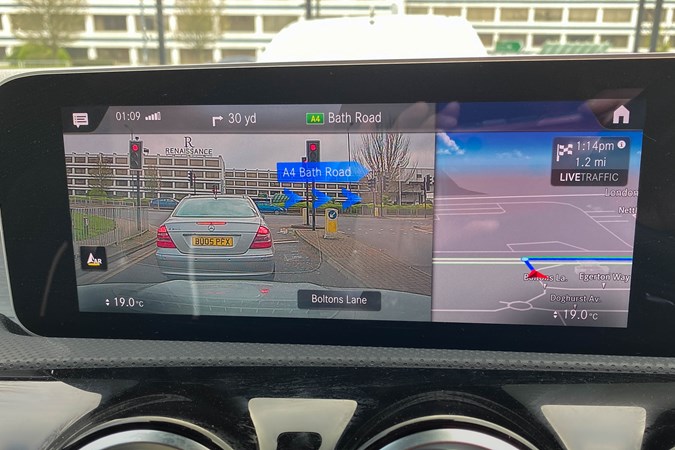
However, what you miss out on by saving £1,500 skipping Premium Plus is…
- Panoramic sunroof. This would transform the car’s interior and looks good
- Multibeam LED headlamps, with highbeam assist – see below
- Electrically-adjustable seats with lumbar support. That’s right; the lower-spec models don’t have lumbar support
- Traffic-sign assist
It is entirely reasonable to consider skipping the upgrades of Premium, but if you’re going for Premium and a mid-range engine, I’d downgrade the engine and go for Premium Plus. The car will feel so much more special for it.
Multibeam LED lights: why you want to get Premium Plus
As great as a sunroof would be, there’s one feature I really wish the CLA Shooting Brake on all models, and it’s part of that Plus package. Adaptive LED headlights.
I cannot emphasise this enough, the standard LED headlights are strangely unsuited for UK roads. The beam is bright and even, but cuts off abruptly and doesn’t extend far enough ahead, leaving you staring into darkness looking for potential hazards if you’re polite enough to dip the lights early or have them dipped on urban roads with sparse lighting or motorways.
The full beam is, of course, absolutely fantastic. Bright, clear and with a long range.
You’re always switching high beams on to try and get the most visibility – and there’s no auto-dipping, which on a car costing almost £40,000 in 2021 is almost unforgiveable. Superminis costing half as much have better lights.
Don’t take my word for it, as eyesight varies and comfort is subjective – make sure you test drive the car at night with oncoming traffic, urban and rural roads for comparison. This is the second Mercedes I’ve had where the LED lights have been difficult to live with, and colleagues and friends agree that they just don’t feel right when dipped, like they cut off too soon – yet the dealers insist they are correct.
Even a Dacia Sandero with LED lights illuminates further ahead, so I’m sure there’s something awry with Mercedes’ specs for right-hand drive LED lights.
We get the opportunity to compare the Mercedes-Benz CLA Shooting Brake with a couple of alternatives – the Volkswagen Golf Estate specced up to a similar cost, and the trendy Mercedes GLA SUV with hybrid petrol power.
Mercedes CLA Shooting Brake vs Volkswagen Golf Estate
This should not be a fair test – the Golf Estate is squarer, cheaper and less powerful than the CLA Shooting Brake. However, they’re both cutting-edge German small family estate cars that you can easily spend well over £30,000 on without choosing the ludicrous models. If transport for you and your kids is the priority, that Mercedes has chosen to make the CLA really good looking may not be as important once you’re behind the wheel and commuting every day.
So, our contenders are ‘my’ CLA Shooting Brake – 2.0-litre diesel automatic, AMG Line Premium – and a VW Golf Estate in Style trim, with a fair chunk of options and the 150hp diesel with DSG automatic.
List price for the Golf as tested is just under £37,000 – so the two cars are more closely aligned than you might expect. You lose a lot of power compared to the CLA, and there’s no denying that the cars have very different styles; the Golf is striking, bold, and in dark blue metallic a handsome, if rather technical looking car.
The CLA Shooting Brake has a more classical beauty to the lines, sensuous curves and a subtle progression from nose to tail that takes a little longer to appreciate, but stands out in a car park remarkably effectively.
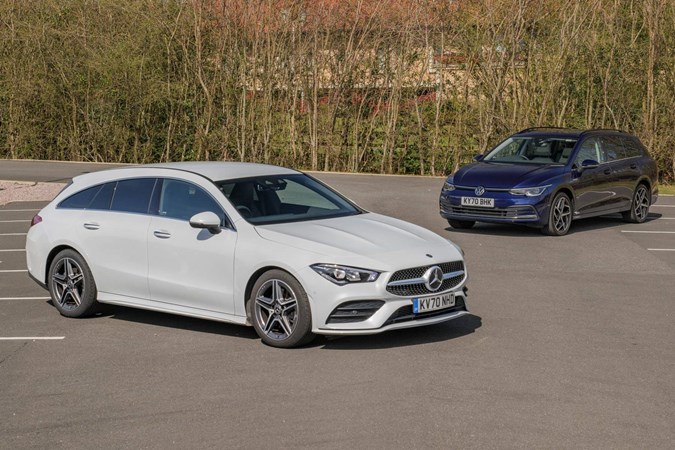
Looks aren’t everything though…
What’s the Mk8 Golf Estate like to drive and live with?
First impressions show the kind of detail thinking that has defined modern VW’s image of quality.
If anything, it works in reverse to the normal – hard plastic trim where you can see it is supported by touches like soft, felt-like lining to the door bins, a light headlining (in this car, augmented with a large opening sunroof) and supportive, wide, comfortable seats with lumbar support. The dashboard is the controversial touch sensitive setup that all Mk8 Golfs have, and that’s probably the most disappointing part of the car.
The CLA looks snazzier – reflecting the difference outside – but the Golf’s interior is absolutely free of rattles (unlike my CLA), and there are some genuinely nice touches if you’re comparing them as family cars; a third heater zone for the rear passengers, clever smartphone/game-console sized pockets on the back of the seats, Isofix on the front passenger seat and storage for the parcel shelf in the boot floor.
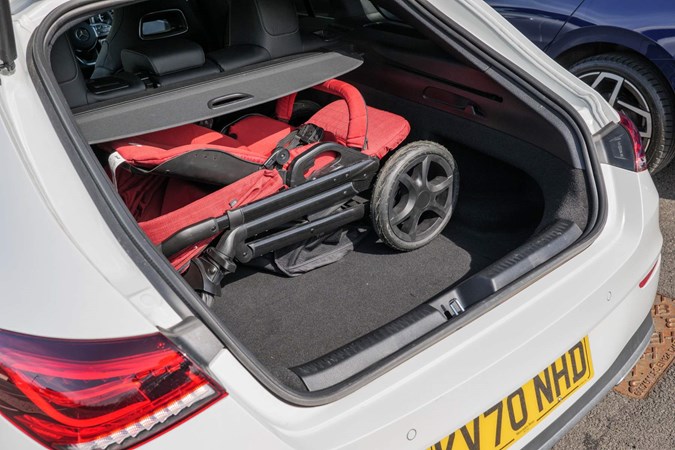
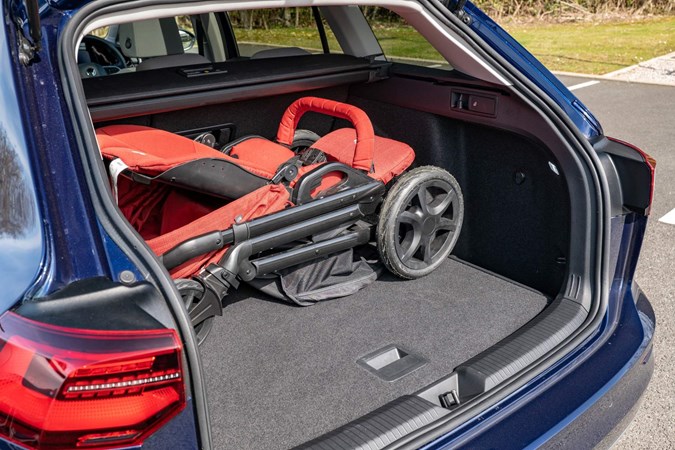
Both cars have good ergonomics, clear displays and easy, light controls, and they also both seem to have been designed without anyone having thought about where the phone’s going to go when connected to the infotainment. The Golf’s cupholders are further back, though they are in a bigger pocket with a pop-out insert for cans, whereas the Mercedes hides them, and the phone, beneath a lovely sliding cover that can’t be closed if you have a normal-sized iPhone connected.
When it comes to the technology and infotainment in particular, the Mercedes pulls away with a clear lead.
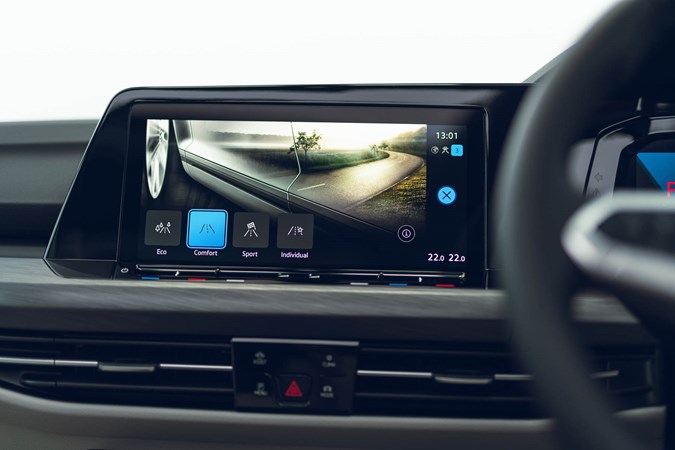
From the initial stalled-start of the VW’s touch interface in the first place, to the lack of controls you can use without reaching for the display meaning you have to reach for the screen all the time in the Golf, to the quality of Mercedes’ voice control, the Shooting Brake is more satisfying as a gadget, an electronic companion and a thing to show off.
The Mercedes has three hardware touch interfaces, one big one in the centre the passenger can use as well, and two small pads on the wheel – in addition to the screen itself, and hardware controls for ventilation. At this price, it’s also got a better audio system too.
Don’t get too smug, though. The aforementioned noisy idle and interior rattles of the CLA throw the solidity and serenity of the Golf into sharp relief. This may only be an issue for our test car, but that it’s even possible for one to escape quality control like this is concerning.
At speed, both cars have similar noise levels, with the Golf’s slightly louder overall noise at 70mph offset by the lack of higher-frequency whistles; neither is the last word in refinement.
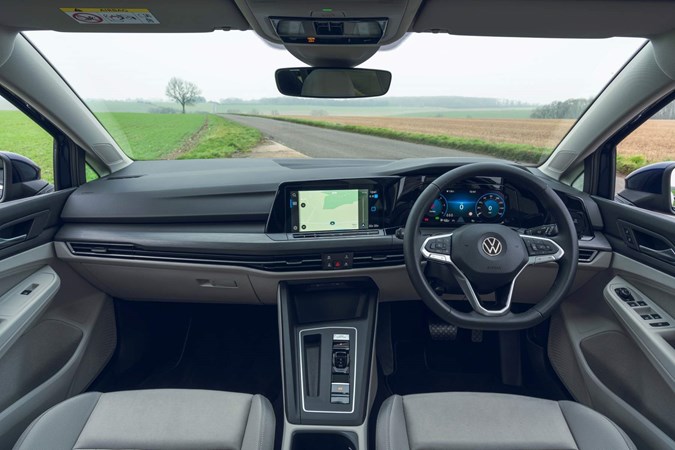
Where the Golf really surprises is in the handling. Not the ultimate ability to stay stuck to the road – both cars can comfortably exceed any socially-responsible or even ‘a bit lairy’ driver’s limits – but in how much feedback and precision there is for the driver. It’s genuinely good – not ‘classic old Golf’ mechanically sharp, but direct and communicative without being tiresome. The presence of ‘Travel Assist’ at this budget helps, as the Golf’s system is one of the best lane-keeping adaptive cruise controls I’ve used.
The CLA isn’t bad behind the wheel at all, though it lacks adaptive cruise and also has the most intrusive ‘lane correction’ system known to humankind (let yourself drift over the shoulder line to give room for a tractor to be passed, and it’s 50/50 whether the car will slam the brakes on and steer you into the path of the oncoming car). It’s just that for a driver who enjoys driving, the Golf can be more rewarding.
Once again, the tables turn when the brake pedal comes into play. The CLA Shooting Brake’s, er, brakes are excellent, with a progressive, reassuringly firm pedal that doesn’t need much force, but doesn’t feel over-assisted either. By comparison the Golf feels a little wooden for smaller adjustments.
Comparing the gearboxes propels the CLA even futher forward. No matter what else the CLA does, the Mercedes automatic is fantastic – unobtrusive, smooth, always in the right ratio and easy to control with the column stalk; it’s ready at roundabouts, drops down smartly to overtake, and you barely notice the shifts in normal driving. The Golf shares the usual DSG gripes of sluggish roundabout shifts and rather ponderous gearchanges, plus a control on the dash that requires a bit of patience to get reverse.
With British speed limits and road conditions to consider, the Golf is – marginally – the more satisfying to drive in my opinion. The flipside is that the Mercedes has more power and it shows when overtaking, and both cars fall short of long-distance comfort perfection; the Golf for fabric seats that aren’t well ventilated on warm days and offer less adjustment overall, the CLA for rather deep side bolsters and no lumbar support. Both cars can be improved with upgraded seats, of course.
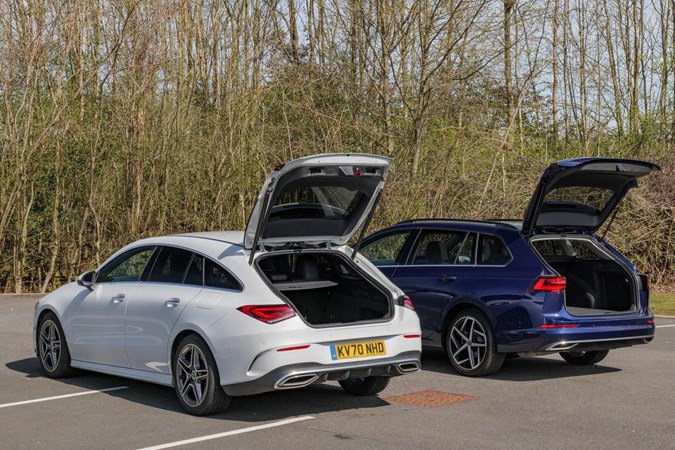
In terms of practicality it’s closer than you think day-to-day, with the CLA’s deep boot and powered tailgate extremely good for shopping and luggage, where the Golf offers that extra bit of ability when you do need to carry bulkier items – and has a generous under-floor space where the spare wheel would live that also stores the parcel shelf.
For your £38,000 budget though, you get a Golf Estate with a large, opening panoramic sunroof, adaptive LED headlights and some cash left over.
I’m genuinely torn between the two – as lockdown has eased and I’ve been able to see the CLA Shooting Brake in more locations, different light and enjoy driving it a bit it has grown on me for its strengths, and it is undeniably a good-looking, sensibly sized car. Yet the Golf comes with all the kit I want and has that incredibly useful ability to carry bulky items that the CLA loses not because it’s too small, but because the tailgate is so much narrower than the car’s cargo area.
Verdict: Golf Estate vs CLA Shooting Brake
If it came down to the exact cars tested, then the Golf would get my money.
If a Mercedes dealer was offering an ex-demo CLA Shooting Brake. in a colour other than white, with Premium Plus and less intrusive petrol engine, for the same price as the new Golf – I’d take the Mercedes and hire a small van when I needed to move bulky things.

Mercedes CLA Shooting Brake vs GLA 250 e hybrid – fashion vs trend?
One of the reasons I like the CLA is that it goes against the grain, and the popularity of taller, pseudo off-road cars. As a fan of cars that are ‘fit for purpose’, the idea of using a two-tonne SUV that can’t really go off-road for school runs, commuting and shopping trips is baffling to me, but even before reading this quick comparison I have to admit, I much prefer the GLA to drive in day-to-day situations.
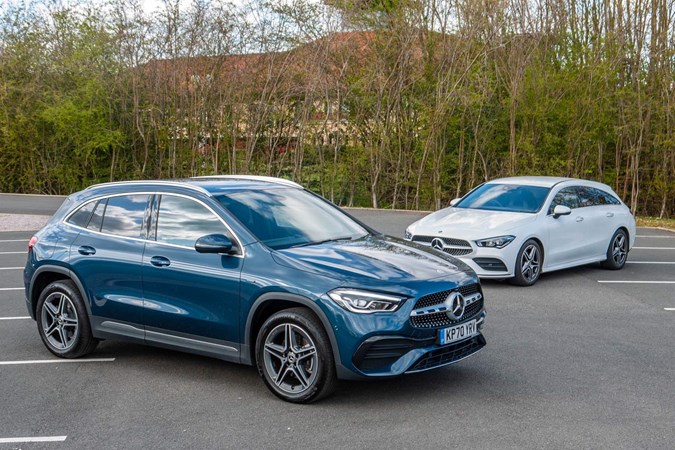
Consider me SUV-shamed like the rest of Britain; I’ll go join the queue for a Qashqai.
Seriously, though, comparing the Mercedes-Benz GLA and CLA Shooting Brake really does underline why this class of car – whether you call them crossovers or SUVs or whatever – has so much appeal to everyday users. It’s just so easy to live with.
We’ve got a GLA 250 e AMG Line, which would cost ‘around £39,000’. At the time of writing the GLA series is being shuffled and the only option presented is the ‘Exclusive’ which comes with full leather and a couple of other options, but as with the CLA you really want the Premum/Plus packs to get all the goodies.
Specification as tested:
- £38,390 AMG-Line GLA 250 e
- 201.mpg and 32g/km CO2
- 0-62mph 7.2 seconds, and up to 147mph
- 4,695mm long, 1,433mm high, 1,999mm (1,830mm*) wide
- Wheelbase 2,729mm
Mercedes-Benz plug-in hybrid – 250 e
The basics of the plug-in hybrid technology here are shared between all A-Class models (and the B-Class), and one of the reasons we chose the GLA 250 e was to get some idea of what the CLA Shooting Brake would be like so equipped. In short, MUCH better than with the diesel. The GLA isn’t the last word in refinement for road and wind noise, but the engine cannot be faulted for the calm, silent way it goes about moving the car in town.
In the GLA it doesn’t feel quite as potent as ‘250’ vs ‘220’ would suggest, but it’s possible there are differences in how everything is mapped for the two cars. However, the main question of ‘would the CLA be better with the hybrid engine?’ has been answered; yes.
What’s the GLA like
It isn’t entirely a jacked-up A-Class. The interior is different (closer to that of the B-Class) with taller-feeling doors and a higher hip point on the seats, for example.
Despite a relatiely small increase in height – the GLA is not a towering beast of an SUV – the driving position feels far more commanding and authoritative, also giving better sight lines and confidence placing the car on the road.
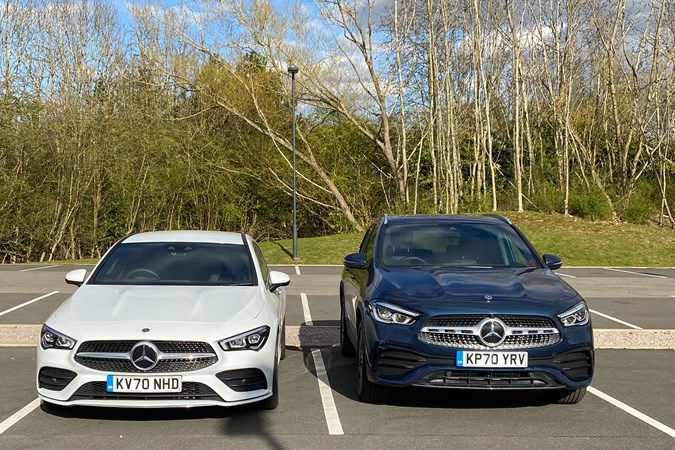
In this moderately low-spec it has manually adjustable seats which are less overtly sporty than the CLA – there are adjustable headrests for a start – but still lack lumbar support. The half-leather trim feels more comforting and grips your jeans in corners, so the car’s not only a touch more welcoming than the CLA’s relentless black leather & plastic. it’s actually no less supportive in bends.
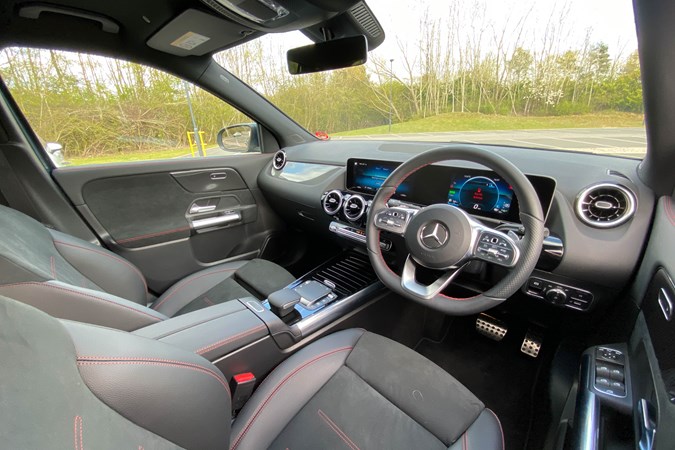
Which is good, because one thing the GLA does deliver is the softer, long-travel float in the suspension you want out of an SUV. While it isn’t going to worry S-Class owners, the GLA’s ride is good for a premum German SUV with ‘AMG’ in the specification. Unlike the CLA Shooting Brake, it rides over road imperfections, crests speedbumps (at sensible speeds) and absorbs rutted, collapsing rural roads with little fuss. It’s easy to feel safe and confident in even on fairly poor surfaces. Usefully larger mirrors and the SLK-style bonnet powerdomes help with positioning on the road, too; it feels like a stylish yet very practical design from the driver’s seat.
Power from the hybrid engine is not earth-shattering – it never feels as quick as the 220 d – but it goes about everything so quietly you don’t care.
Is the GLA a better family car?
Yes. Obviously. The rear seats are higher, the doors are more sensibly shaped, the boot has a full-width opening and less of a drop to load items or indeed, bend down to get them out again, and it’s also shorter, so fits parking spaces better.
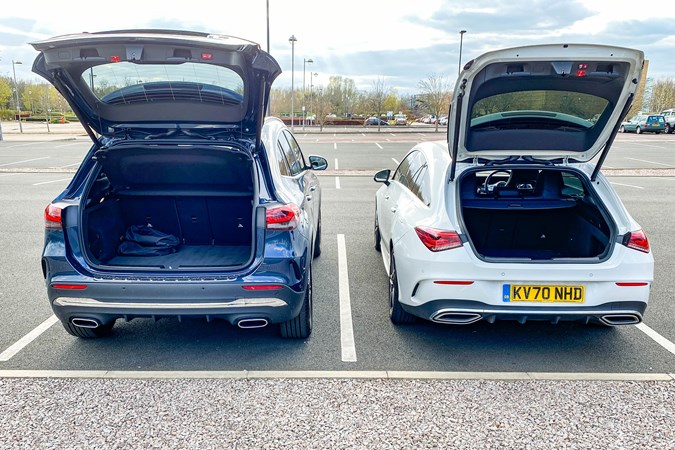
It’s easy to see why small SUVs have become so popular when you drive the two back-to-back, but the CLA Shooting Brake is arguably more practical unless you regularly carry very bulky loads, and is much more satisfying to drive on good, fast roads. It’s also, objectively, a much better looking car. Yet the appeal of the GLA’s comfort and higher driving position is hard to deny.
However, there are better plug-in hybrid SUVs out there. The saving grace for the GLA 250 e is that it’s actually cheaper than a Toyota RAV4 plug-in hybrid; it needs to be, lacking range and 4x4 capability.
Update 7: Mercedes-Benz CLA 220 d Shooting Brake Verdict
After six months with this CLA, I’ve reached two conclusions:
One, that the Mercedes-Benz CLA Shooting Brake is a really stylish, yet genuinely practical family car that looks good on the road, impresses friends and neighbours, and doesn’t cost a fortune to run. It’s an estate car that puts vanity ahead of utility, but it does so incredibly well, and retains a huge amount of practicality despite its sporty looks.

Two, it really should not be bought with the diesel engine, no matter how much you like the impressive economy figures.
While the whole Parkers team agrees that our CLA Shooting Brake is unusually harsh, loud and rattly inside at idle, we’re not all convinced that there’s a fault causing it (it drives perfectly otherwise) and at least some of that rattle is down to things that definitely aren’t broken – like the compartment for the manual in the glovebox.
The 220 d version is just a bit too… gritty… for such an otherwise pretty car. If nothing else, take a long test drive with a cold start before deciding.
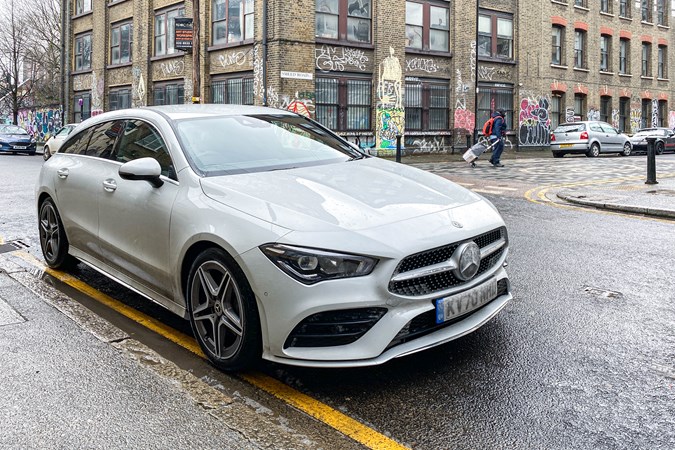
Being realistic, if economy is your first thought when looking at a Mercedes-Benz CLA Shooting Brake – an aspirational, sporty, luxury brand, after all – then rather than a few quid clawed back by going for diesel you’ll save even more money buying something more practical in the first place, even from Mercedes.
It would make more sense to get the cheapest CLA 180 Shooting Brake and enjoy the lovely shape, frameless doors and surprisingly spacious (if not particularly suited to big items) boot for as little money as possible, with a characterful but moderately slow petrol engine, rather than the refinement-breaking diesel.
The quality isn’t quite where you would want it to be from a Mercedes-Benz, but it’s not too far out for the price of the car. You are paying more for style than material, fit and finish though, and for a marque that carries a reputation of engineering quality that’s disappointing.
Where the CLA Shooting Brake really makes sense is as a Mercedes-AMG CLA 35 4Matic Premium Plus, with a list price around £48,000 and potentially, much better value via brokers and dealers when incentives are on offer.
In that, you can enjoy genuinely luxurious trim with generous equipment, a powerful but refined petrol engine and the security of all-wheel drive grip in a car that not only has the performance to rival the likes of a Golf R or Audi S3, but has looks that most people will find considerably more appealing and impressive than either of those dressed-up hatchbacks..
Further reading




